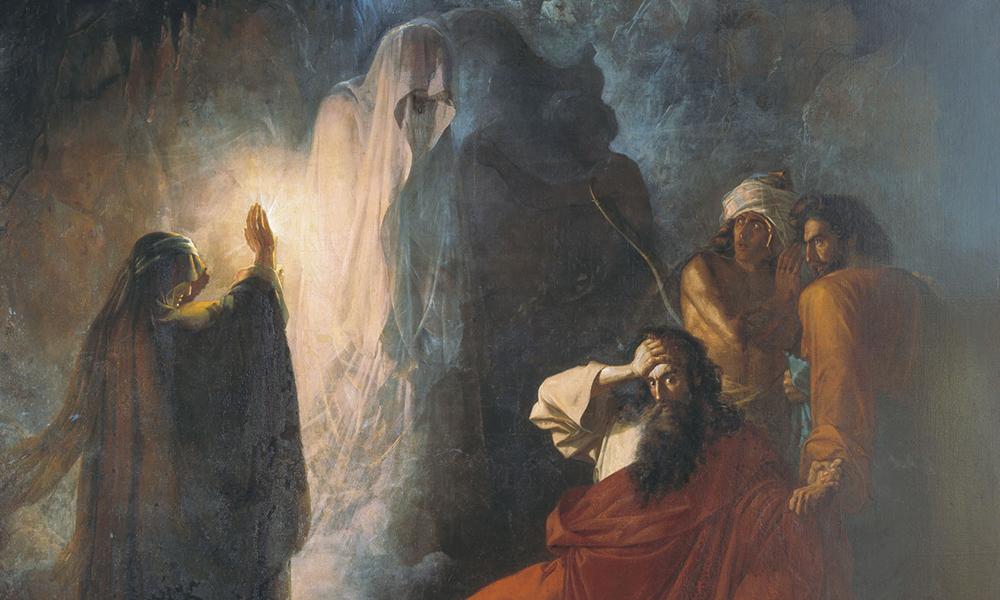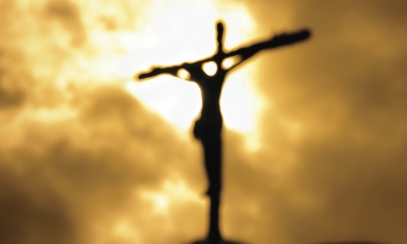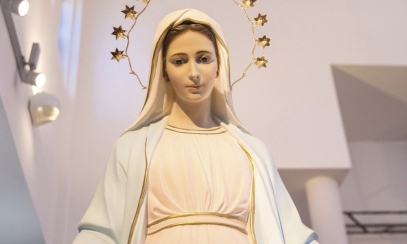
The Ghost and Aquinas
Halloween is on the horizon, which means that images and costumes of ghosts are filling our television screens and streets. Even children’s cartoons join in with ghost-themed episodes at Halloween. When my youngest daughter saw one of these shows, I tried to assure her (in my best “dad voice”) that “ghosts aren’t real.” Now, though, I’m not so sure. Recently, I learned that one of our greatest theologians, St. Thomas Aquinas, expressed his belief in the reality of ghosts and reportedly had some personal encounters. Records indicate that Aquinas was visited by a Brother Romanus (whom he didn’t realize had died), and by the saint’s deceased sister.
Halloween is on the horizon, which means that images and costumes of ghosts are filling our television screens and streets. Even children’s cartoons join in with ghost-themed episodes at Halloween. When my youngest daughter saw one of these shows, I tried to assure her (in my best “dad voice”) that “ghosts aren’t real.” Now, though, I’m not so sure. Recently, I learned that one of our greatest theologians, St. Thomas Aquinas, expressed his belief in the reality of ghosts and reportedly had some personal encounters. Records indicate that Aquinas was visited by a Brother Romanus (whom he didn’t realize had died), and by the saint’s deceased sister.
In his Summa Theologiae, Aquinas wrote: “It is absurd to say that the souls of the departed do not leave their abode.” “According to the disposition of divine providence,” he wrote, “separated souls sometimes come forth from their abode and appear to men. …It is also credible that this may occur sometimes to the damned, and that for man’s instruction and intimidation they be permitted to appear to the living.” (Think of Marley in Charles Dicken’s A Christmas Carol.)
It’s important to remember that an opinion of a theologian is just that – an opinion. There still has never been an official Church teaching on this question. Therefore, as Catholics we are left to form our own opinion unless the Magisterium (i.e., the Church’s teaching office composed of the pope and bishops in union with him) decides to clarify the matter. My sense is that we shouldn’t hold our breath…
I don’t believe I’ve ever seen a ghost. But I did have a strange encounter in 1992, soon after I arrived as a lay missionary in the former USSR. A group of us missionaries had to reside for a time in a wing of an old Soviet university. One night, a fellow missionary and I awakened with an uneasy feeling. We left the dorm room and tiptoed to the darkened kitchen area. Was there perhaps an intruder looking to rob us Americans? Suddenly, glasses and dishes began spontaneously breaking all around us. We immediately started praying and the disturbance stopped. My friend and I quickly concluded that some malevolent spirit was not happy that a group of us had arrived to spread the Good News in these former communist lands.
It is clear that some of Jesus’ followers did believe in ghosts, but somehow I never took their point of view very seriously: “When the disciples saw him walking on the sea they were terrified. ‘It is a ghost,’ they said, and they cried out in fear. At once Jesus spoke to them, ‘Take courage, it is I; do not be afraid’” (Mt 14:26-27). Later, when the Lord had risen from the dead, their same fear resurfaced: “[Jesus] stood in their midst and said to them, ‘Peace be with you.’ But they were startled and terrified and thought that they were seeing a ghost. Then he said to them, ‘Why are you troubled? And why do questions arise in your hearts? Look at my hands and my feet, that it is I myself. Touch me and see, because a ghost does not have flesh and bones as you can see I have’” (Lk 24:36-39). The most famous account of a ghost in the Old Testament is when the witch of Endor seems to conjure the ghost of the prophet Samuel at Saul’s request; however, many Fathers of the Church considered this to be a diabolical manifestation – not truly Samuel’s ghost (see 1 Sm 28:5-20).
Peter Kreeft, a philosopher and author of many theological works, has offered his opinion that “the dead often do appear to the living. There is enormous evidence of ‘ghosts’ in all cultures.” “Ghosts appear on earth, but do not live on earth any longer,” he contends. “They are either in heaven, hell, or purgatory.”
This mention of purgatory beings to mind a family friend of ours who lives in Ohio. She is deeply devoted to praying for the souls in purgatory as they await their liberation into heaven. One night, her elderly grandmother (who lives in a separate home) fell – and was unable to get up. The next day, the mother told her daughter how grateful she was that a man was there to help her rise off the floor. The mom said that when she turned around to thank this mysterious gentleman, he was no longer there. Our friend was convinced that one of the holy souls in purgatory had appeared to help her grandmother, perhaps as a thank you for all the prayers she had offered.
It’s important to remember, though, that the Church strictly forbids us from trying to summon deceased persons or forecast the future through on our own initiative. “All forms of divination are to be rejected: recourse to Satan or demons, conjuring up the dead or other practices falsely supposed to ‘unveil’ the future. Consulting horoscopes, astrology, palm reading, interpretation of omens and lots, the phenomena of clairvoyance, and recourse to mediums all conceal a desire for power over time, history, and, in the last analysis, other human beings, as well as a wish to conciliate hidden powers. They contradict the honor, respect, and loving fear that we owe to God alone” (Catechism of the Catholic Church no. 2116).
Peter Kreeft speculates that there are three categories of ghosts: “Sad, wispy” ghosts which are souls in purgatory hoping for our prayers and sacrifices; “malicious and deceptive spirits” that come from hell, often summoned through séances or the use of a Ouija board; and the “bright, happy” spirits of deceased friends or family members. Clearly, the best response to a ghostly encounter is prayer. If we sense the spirit is demonic, ask Jesus to drive it away. If from purgatory, pray for the soul to enter heaven. And if it is a benevolent visitor from heaven, thank God for this special grace.
As interesting as Kreeft’s opinions may be, when it comes to “ghosts” Catholics are on surest ground in three specific instances. First, we can fully affirm that the apostles Peter, John and James truly beheld the apparitions of two heavenly visitors at the Transfiguration of the Lord: Moses and Elijah (see Mt 17:1-8). Secondly, we are free to affirm the reality of Mary’s appearances in approved apparitions such as Lourdes and Fatima, though we are not strictly required to do so. These are private revelations, so the Church leaves us free to believe or not believe. Finally, there is one “Ghost” we not only profess to believe in, but whom “with the Father and the Son” we adore and glorify – the Holy Ghost. (“Ghost” comes from the German “Gheist,” meaning “spirit.”) The third person of the Trinity is not a “ghost” in the colloquial sense, of course. He is a divine person, infinite, uncreated Spirit, God the Holy Spirit. And although “Spirit” is the word now commonly used in America, we can still hear the older term whenever we musically invite him to be our guest in the words of that beloved ancient hymn: “Come, Holy Ghost/Creator blest/ And in our hearts take up thy rest!”
Spiritual Health 101
Interest in the occult is on the rise. The Catholic Church, however, teaches that “all practices of magic or sorcery, by which one attempts to tame occult powers, so as to place them at one's service and have a supernatural power over others - even if this were for the sake of restoring their health - are gravely contrary to the virtue of religion…” (CCC no. 2117).
The Church cares deeply about the spiritual wellbeing of all people, and therefore warns against the following practices that can open a door to the activity of the evil one and other fallen angels:
- Ouija boards
- Séances
- Tarot cards, fortune telling or palm and horoscope readings
- New Age practices like channeling, using crystals, etc.
- Opening oneself to “energies” in certain Eastern spiritual practices
- Wicca
- Wearing magical charms
- Incantations, hexes, conjuring and casting spells, whether it be “white magic” or “black magic”
Note: It may be surprising to many people, but exorcists are reporting that when they have commanded demons to reveal how they entered the lives of possessed persons, some evil spirits have responded with works of fiction depicting witchcraft.
The Church recommends ways to spiritually protect ourselves and our families, including:
Baptism (I know of a young man who was suffering spiritual attacks and it all stopped once he was baptized)
Frequently receiving the sacraments of Eucharist and Penance (confession)
Prayer and eucharistic adoration outside of Mass
Having our homes blessed by a bishop, priest or deacon
Using sacramentals such as holy water, blessed salt, or wearing a blessed medal
Having crucifixes and holy images in our homes (blessed, if possible)
Consecration to the Sacred Heart of Jesus and the Immaculate Heart of Mary
Devotion to Mary, including praying the rosary, wearing a scapular, etc.
Invoking the Holy Names of Jesus and Mary
Invoking St. Joseph under his title “Terror of Demons”
Pope Leo XIII’s prayer to St. Michael the Archangel
Dr. Dan Osborn is the Diocesan Theologian and Coordinator of Permanent Diaconate Formation & Ministry for the Diocese of Saginaw.



